

Living the Change - Happen Films. Living the Change is a series of short documentary films that focus on permaculture, tiny houses, backyard gardeners, natural buildings, simple livers, and anyone with an inspiring story to tell about the transition to a new and more resilient way of life.
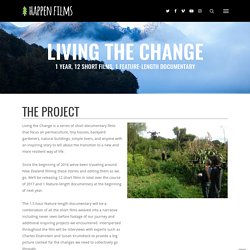
Since the beginning of 2016 we’ve been traveling around New Zealand filming these stories and editing them as we go. We’ll be releasing 12 short films in total over the course of 2017 and 1 feature-length documentary at the beginning of next year. The 1.5 hour feature-length documentary will be a combination of all the short films weaved into a narrative including never seen before footage of our journey and additional inspiring projects we encountered.
Interspersed throughout the film will be interviews with experts such as Charles Eisenstein and Susan Krumdieck to provide a big picture context for the changes we need to collectively go through. This project wouldn’t be possible without the generous support of our viewers. Backyard permaculture – pre-design thinking. Now that I’m half way through my Permaculture Design Certificate (PDC) theory, I’m about to take a really good crack at some intentional design in terms of applying permaculture principles in an average sized garden.
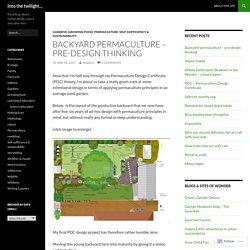
Below, is the layout of the productive backyard that we now have after five-six years of ad-hoc design with permaculture principles in mind, but without really any formal or deep understanding. [click image to enlarge] My final PDC design project has therefore rather humble aims: Moving this young backyard farm into maturity by giving it a vision and including: removing the last of the invasive lower lawn for veg bedscreating more vertical veg growing space,connecting it to the front yard which is now an emerging food forest toosolutions for unused wasted sides of the housedeveloping a natural play area for the kids. Perennialsolutions. April 19, 2013 User Admin This article is an excerpt from my forthcoming book Carbon Farming: A Global Toolkit for Stabilizing the Climate with Tree Crops and Regenerative Agriculture Practices, and is part of a series promoting my kickstarter campaign to raise funds with which to complete the book.
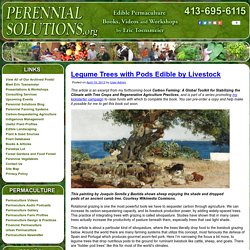
You can pre-order a copy and help make it possible for me to get this book out soon. This painting by Joaquin Sorolla y Bastida shows sheep enjoying the shade and dropped pods of an ancient carob tree. Courtesy Wikimedia Commons. Rotational grazing is one the most powerful tools we have to sequester carbon through agriculture. This article is about a particular kind of silvopasture, where the trees literally drop food to the livestock grazing below. 7 Steps to Vermicomposting.
Having a compost bin on an apartment balcony is completely doable.
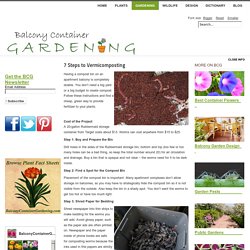
You don’t need a big yard or a big budget to create compost. Follow these instructions and find a cheap, green way to provide fertilizer to your plants. Cost of the ProjectA 20-gallon Rubbermaid storage container from Target costs about $13. Worms can cost anywhere from $15 to $25. Step 1: Buy and Prepare the Bin Drill holes in the sides of the Rubbermaid storage bin, bottom and top (too few or too many holes can be a bad thing, so keep the total number around 20) for air circulation and drainage.
Step 2: Find a Spot for the Compost Bin Placement of the compost bin is important. The Top 3 Balcony Composting Methods. By Tyler Weaver For balcony container gardeners who live in a city or have limited space, look no further than the balcony to begin processing food scraps into compost for the container plants in the garden.

Aprende a reciclar el agua de lluvia como en este proyecto lo hicieron de forma sensacional – manos a la obra. Manos a las Obra les trae hoy este proyecto para recopilar agua de lluvia y transformarla en agua potable, si vives en una zona donde no hay acceso a los servicios de agua o suelen tener cortes repentinos a causa de desastres naturales entonces este post te será de gran ayuda.
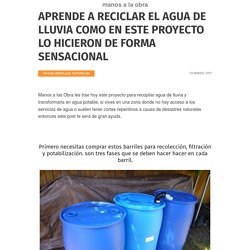
Primero necesitas comprar estos barriles para recolección, filtración y potabilización. son tres fases que se deben hacer hacer en cada barril. En tu jardín haz un espacio para trabajar los cortes de madera para el marco de los barriles. Nat Geo Launched a Free Website for Printing Detailed Topographical Maps. ECOFACT2a. For Gardening, Nature and Adventure Lovers. The Edible Schoolyard Project. Pastured Poultry Profits. Welcome. Permaculture, livelihood, design, diversify, polyincome. Many people are unhappy in their jobs and yet most don’t do anything about it.

Discovering permaculture can be the catalyst for us to start considering how we might make that transition to the more positive-impact lifestyle we aspire to. At first it may seem that the only available permaculture livelihoods are as a teacher or food grower, but these are just the visible ‘front end’ of a wide network of inter-dependencies. While teaching and writing are my passion, I currently still manage my own websites, do my own accounts and convene some of my own courses. I gained those skills out of necessity, but would love to be able to call on them from within the permaculture community to free up my time for the things I’m more interested in. So this article shares some ideas and reflections in the hope it will help bring more of you into the permaculture economy.